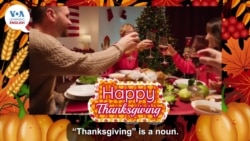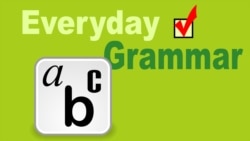Americans will soon celebrate Thanksgiving. The holiday involves family, friends and food.
A common expression Americans say to each other at this time of year is “Happy Thanksgiving.”
In the spirit of Thanksgiving, we will pay careful attention to the first word in the expression: happy. You will learn about the history and usage of this common, five-letter adjective – and its related noun form.
Let's start.
A helpful way to learn words
We can bring words to life by learning about their histories. In this way, words become like close friends – we know their backgrounds, their beginnings, and how they have changed over time.
Happy is – and always has been – a positive word.
The Online Etymology Dictionary says the word dates to the 1300s. At the time, it meant “lucky, favored by fortune... prosperous” as well as “very glad.” Soon after, it came to mean “greatly pleased and content.” The Dictionary also tells us that the majority of the words for “happy” in European languages first meant “lucky.”
From the word happy, we also have a noun form: happiness.
When we compare the adjective “happy” with the noun “happiness,” we find that English speakers use “happy” much more often.
That information comes from Google’s Ngram Viewer, an online database that examines thousands of books.
Modern usages
We have learned a little about the history of the adjective “happy.” So, how do English speakers use it in modern times?
Perhaps the most common usage is after linking verbs. These are verbs that link their subjects with their predicates. Adjectives are commonly used after linking verbs to describe the subject.
Google’s Ngram Viewer says some of the most common structures involve the verb BE. For example, you are very likely to hear or read: “I am happy,” or “he was happy.”
We also use “happy” with other kinds of linking verbs – feel, seem, and others.
Happy is also used with intensifiers – words that make an adjective stronger. Two of the most common, Google’s Ngram Viewer tells us, are “so” and “very.”
These intensifiers are then used along with linking verbs. Consider these examples:
You look so happy!
We are very happy.
They seem so happy.
In all of these examples, the structure is linking verb + intensifier + happy.
A few final words on the modern usage of “happy.” You are also likely to hear the adjective “happy” used to express kind wishes around some holidays – Thanksgiving, for one.
In America, you will often hear statements such as this:
Happy Thanksgiving!
These statements are a kind of sentence fragment, or an incomplete sentence. There is no subject. The subject and main verb are understood between the speakers.
A complete sentence would be “I wish you a Happy Thanksgiving” or “I hope you have a Happy Thanksgiving.”
We shorten these sentences because the first part is understood. That is how we arrive at “Happy Thanksgiving.”
Closing thoughts
In today’s report, we explored one word: happy. You learned about its history and common usages with linking verbs and intensifiers as well as holiday wishes.
You may or may not celebrate Thanksgiving where you live. But we can end this lesson by wishing you a very happy day.
I’m John Russell.
John Russell wrote this lesson for VOA Learning English.
_______________________________________
Words in This Story
fortune – n. something that happens by chance; the good and bad things that happen to someone
prosperous – adj. having success usually by making a lot of money
glad – adj. feeling pleasure, joy, or delight
predicate – n. the part of a sentence that expresses what is said about the subject










Forum